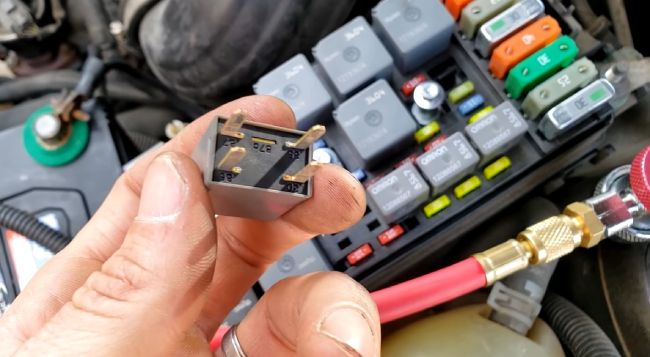Having air conditioning in your car blowing warm air is a sign that something is wrong with the AC system. The most frequent reason is a faulty AC compressor clutch.
Here will look at reasons why the compressor clutch is not working, signs it is defective, and how you can fix it.
The AC Compressor Clutch

When you turn on the air conditioning in your car, it energizes the electromagnetic coil attached to the pump rotor by the electromagnetic force; turning the compressor that compresses the refrigerant.
The AC clutch makes the AC compressor turn. This AC clutch is connected to the flywheel by a belt that spins the flywheel to initiate power. The electromagnetic switch joins the flywheels rotating shaft to the shaft.
Turming on the car’s AC, engages the spinning pulley, which energizes the clutch that activates the AC compressor. The electromagnetic coil is adjacent to the friction plate; these make up the AC compressor clutch.
The AC compressor is the working center of your air conditioning system. If you don’t keep it in good working order, your air conditioner will blow hot air.
Why is the AC Clutch Not Engaging?
Clutch Fuse is Blown
While the clutch fuse is often to blame for the clutch not engaging or turning, you need to figure out what is causing the fuse to fail. It is often caused by a faulty clutch assembly or a shorted hot wire.
Remove the fuse that runs the ac and test it with the multimeter.
Low-Pressure AC
Your refrigerant may be low, causing the AC compressor to run on low oil and making the clutch faulty.
Clutch Relay Defect
You can check the clutch relay by unplugging the connector at the clutch oil, starting the AC, and checking the battery’s voltage
Defective AC Compressor Clutch
The cause could be bad clutch oil or a bad air gap.
Screeching AC Compressor Clutch
Could be caused by accumulating rust in the pulley and clutch plate, or improper air gaps.
Can’t Engage AC Compressor Clutch
The problem is from bad clutch oil or improper air gaps.
Warm Air from The AC
There is only one reason this happens, the clutch is slipping, and the AC can’t blow out cold air.
Examine the AC Compressor Clutch
Method # 1
Turn your air conditioning controls to the highest setting with the car on, then shut off the car. Looking at the clutch, check its condition.
Look for the clutch and pulley to spin. If just the pulley is spinning, you have a compressor clutch problem.
Method # 2
In some cars, a compressor clutch relay issue is caused by a low-pressure switch.
The computer system grounds the relay; when the switch is defective, the ground relay may go on and off. You can pinpoint the problem source with a good inspection.
For this step, you need to detach the clutch oil from the connector cable and touch the other components.
To measure the battery’s voltage and ground at the detached connector cable, use the digital voltmeter.
If you can’t read the battery’s voltage, you can check the fuse, if the fuse is ok, check the clutch relay.
Method # 3
The compressor needs oil to function, so you need to ensure it gets enough.
There are cars where the air conditioning system power flows from the AC switch to a fuse before it relays to the clutch oil via the low-pressure temp.
If you are positive the problem is the clutch, it will need to be manually engaged.
Tools for Jumping AC Compressor Clutch
- Protective eyewear and gloves
- Freon coolant
- Refrigerant
- Charging hose
- Thermometer
How to Jump AC Compressor Clutch?

Step 1: Figure Out the problem
The AC clutch will need to be jump-started if you have tried several times to engage the compressor and failed.
Connect the clutch wire to your battery Cold air may be caused by a faulty relay or the pressure switch. If the compressor fails even with the clutch engaging, you will need a new compressor.
If you have done all of this and it does not work, replace it right away! If the AC compressor clutch isn’t engaging, you can look into things.
Step 2: Pulley Check
Turn your air conditioning controls to the highest setting and turn the car on. Looking at the front compressor clutch, see if the pulley is spinning. Your problem is in the system if only the pulley is rotating.
The clutch not engaging can also be from the low-pressure lockout, poor ground, poor clutch oil, a fuse that has blown, or there’s open-wire in the oil.
Step 3: System Components Check
In some cars, the low-pressure switch causes the compressor clutch relay to go off and on. Since the relay is grounded by the computer, you will need to inspect the components thoroughly.
Removing the connector cable from the clutch oil to better look at the power and ground, remove it from the other parts. While the AC is still on the highest settings, use a digital voltmeter to check the battery’s voltage.
Step 4: Fuse Check
If you can’t get a voltage reading, you can check the fuse. If the fuse is good, look at the clutch relay by removing it and checking the socket terminals for power and a relay ground.
The power flow starts in the AC switch, runs to the fuse, then redirects to the clutch oil through the low-pressure evaporator in some cars.
You need to make sure there is enough oil in the AC compressor for it to work.
If the fuse is good, do step # 5.
Step 5: Low Refrigerant Check
A low refrigerant level is another cause of a non-engaging AC clutch. Low coolant and pressure are dangerous to your car; it is also a common reason why the AC compressor clutch won’t engage.
Despite all the DIY info, DO NOT hotwire the low-pressure switch; it is dangerous and can cause permanent damage to the compressor because of the low oil level in the compressor. This is an expensive fix!
Step 6: Freon Coolant Use
Do not aggressively charge the system whether you use Freon coolant or an octane booster. Repair a leaking system first; it can create moisture or air in your system.
When you add the coolant and humidity, acid and sludge will damage your system. Bleeding the system is the fix if this happens.
Step 7: Add the Refrigerant
When adding the refrigerant, you don’t need to hotwire, but you do need to be careful.
First, connect the recharge kit to the port with a low-pressure. The thicker, wider tube is the low-pressure tube. Set the switch to high then, run the system and turn on the blower.
The refrigerant will become fluid when the radiator fans blow. Do not use pressure because the compressor does not work.
Check that the AC compressor clutch engages when you restart the car. If it does not engage, it is time to see a mechanic!
Tips for Jumping the AC Compressor Clutch
- When manually engaging the compressor, ensure there is enough oil
- Routing the jumper wire will prevent it from tangling in the other components that move










Leave a Comment